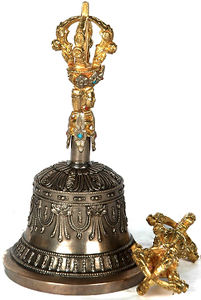Bell: Difference between revisions
Jump to navigation
Jump to search
No edit summary |
No edit summary |
||
| Line 1: | Line 1: | ||
[[Image:Vajra_and_bell.jpg|thumb|300x300px|Bell and vajra]] | |||
The '''bell''' (Skt. ''ghaṇṭa''; Tib. [[དྲིལ་བུ་]], ''drilbu''; [[Wyl.]] ''dril bu'') is, with its necessary counterpart the [[vajra]], an important ritual implement in [[Vajrayana]] practices. It symbolizes the feminine principle, the wisdom of [[emptiness]], while the vajra symbolizes the masculine principle, that of [[compassion]] and [[skilful means]]. And the union of [[wisdom]] and skilful means is the enlightened mind. | The '''bell''' (Skt. ''ghaṇṭa''; Tib. [[དྲིལ་བུ་]], ''drilbu''; [[Wyl.]] ''dril bu'') is, with its necessary counterpart the [[vajra]], an important ritual implement in [[Vajrayana]] practices. It symbolizes the feminine principle, the wisdom of [[emptiness]], while the vajra symbolizes the masculine principle, that of [[compassion]] and [[skilful means]]. And the union of [[wisdom]] and skilful means is the enlightened mind. | ||
Revision as of 12:36, 13 December 2016

The bell (Skt. ghaṇṭa; Tib. དྲིལ་བུ་, drilbu; Wyl. dril bu) is, with its necessary counterpart the vajra, an important ritual implement in Vajrayana practices. It symbolizes the feminine principle, the wisdom of emptiness, while the vajra symbolizes the masculine principle, that of compassion and skilful means. And the union of wisdom and skilful means is the enlightened mind.
Further Reading
- Patrul Rinpoche, The Words of My Perfect Teacher (Boston: Shambhala, Revised edition, 1998), page 187.